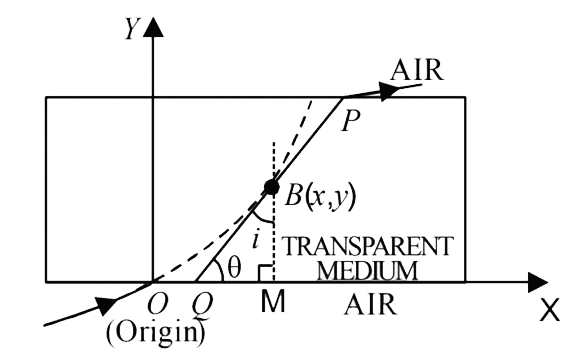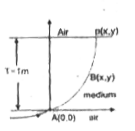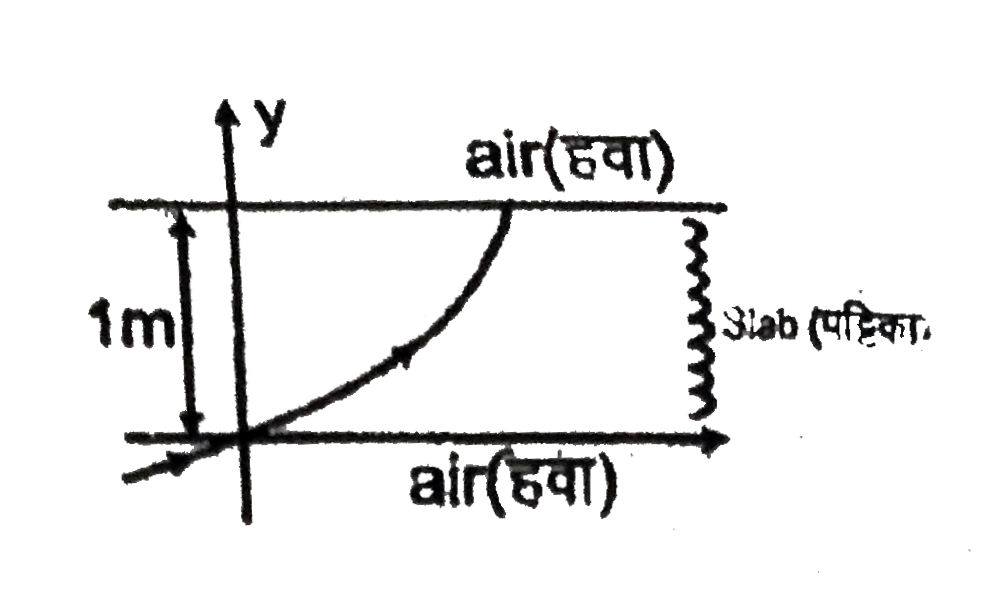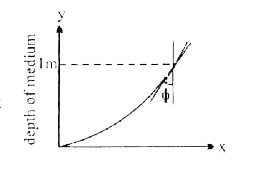A ray of light travelling in air is incident at grazing angle (incident angle=90∘) on a long rectangular slab of a transparent medium of thickness t=1.0 (see figure). The point of incidence is the origin A(O,O) .The medium has a variable index of refraction n(y) given by :n(y)=[ky3/2+1]1/2 ,where k=1.0m−3/2.the refractive index of air is 1.0<br><imga≤ocr_imageload∈g=lazysrc=https://d10lpgp6xz60nq.cloudfront.net/physics_images/NG_PHY_RO_C01_E01_029_Q01.pngwh=80%mx-autosty≤=background:white;><br>(i)Obta∈arelationbetweentheslopeofthetrajec→ryoftherayatap∮B(x,y)∈themediumandthe∈cnt∠attˆp∮<br>(ii)obta∈anequationforthetrajec→ryy(x)oftheray∈themedium.<br>(ii)Determinethec∞rd∈ates(x_(1),y_(1))ofthep∮P.where the ray the ray intersects upper surface of the slab -air boundary.
Indicate the path of the ray subsequently.
The correct Answer is:A, B, C, D

(a) SLOPE AT P
To find the slope at B, we draw a tangent to the trajectory at B. The trajectory is such that as the ray passes through the rectangular transparent medium, the ray continuously deviates towards the normal. The tangent at B makes an angle θ with the x-axis. Therefore, the slope at point B is tanθ=dydx....(i)<br>iisthe∠of∈cnceatBthenaord∈g→triangleBQM<br>i+theta+(pi)/(2)=pi....(ii)<br>Substitut∈gthevalueofthetaform(ii)∈(i)<br>((pi)/(2)-i)=(dy)/(dx)implies(dy)/(dx)=coti...(iii)<br>(b)EQUATIONOFTRAJECTORY<br>Aord∈g→s≠ll'slaw,whenlight∝agatesthroughaseriesofparal≤llayersofd⇔erentmedia,thennsini=constant<br>Letusconsrtherectanga––rstate→bemadeupofparal≤llayerssuchtˆaswemove∈the+Ydirection,theretive∈dex∈creasesasgivenbytherelationship<br>n(y)=[ky^((3)/(2))+1]^((1)/(2)),,,(iv)<br>Apply∈gS≠ll'slawatB,we≥tnsini=const.=1(from above equation)<br>:'n=(1)/(sini)=coseci=sqrt(1+cot^(2)i)=sqrt(1+((dy)/(dx))^(2)),<br>sqrt(ky^((3)/(2))+1)=sqrt(1+((dy)/(dx))^(2))om(iv)implies=(dy)/(dx)=[ky^((3)/(2))]^((1)/(2))implies(dy)/(y^((3)/(4)))=k^((1)/(2))dx=dx(:"k=1)
⇒∫dyy34=∫dx
⇒ y^((1)/(4))=x+CwhereCisan∫egrationconstant.Butatx=0,y=0<br>:'C=0:'4y((1)/(4))=x=impliesy=((x)/(4))^(4)<br>(c)CO−ORDINATES(x_1,y_1)OFTHEPOINTP<br>AtP,y=1m:'x=4y_((1)/(4))=4<br>Thec∞rd∈atesofPare(4m,1m)<br>(d)Theretive∈dexP<br>n_p=[ky^((3)/(2))]^((1)/(2))=[1(1)^((3)/(2))+1]^((1)/(2))=sqrt2<br>ifi_pis∠of∈cnceatPthenaord∫→S≠ll'slaw,<br>n_(p)sini_(p)=1impliessini_p=(1)/(sqrt2)<br>AlsobyS≠ll'slaw,n_(air)sinr_p=n_(p)sini_(p)<br>1sinr_(p)=sqrt2xx(1)/(sqrt2)impliessinr_(p)=1impliesr_(p)=(pi)/(2)implies After emerging from the rectangular glass slab, the light tay becomes parallel to slab length.
Topper's Solved these Questions
Similar Questions
A ray of light travelling in air is incident at grazing angle (incident angle = 90∘) on a large rectangular slab of a transparent medium of thickness t = 1 m. The point of incidence js the origin A (0, 0). The medium has a refractive index of n (y) given
n(y)=(9ky32+1)12
Where K = (meter)−32, The refractive index of air is 1.
Obtain the equation for the trajectory y(x) of the ray of the medium.

View SolutionA ray of light travelling in air is incident on the plane surface of a transparent medium. The angle of incidence is 45∘ and the angle of refraction is 30∘ . Find the refractive index of the medium .
View Solution
Knowledge Check
A ray of light travelling in air is incident at 45∘ on a medium of refractive index √2. The angle of refractive in the medium is
AA. 45∘BB.60∘CC.30∘DD.70∘A ray of light is incident at an angle of incidence 45∘ on an equilateral prism and emerge at an angle 45∘ then the refractive index of the medium of the prism is:
A2B√2C1√2D√3A ray of light travelling in air is incident at grazing incidence on a slab with variable refractive index, n (y)=[ky3/2+1]1/2 where k=1m−3/2 and follows path as shown in the figure. What is the total deviation produced by slab when the ray comes out.
 A60∘B53∘Csin−1(4/9)Dno deviation at all
A60∘B53∘Csin−1(4/9)Dno deviation at all
A ray of light travelling in air is incident at grazing angle (incidence angle =90∘) on a medium whose refractive index depends on the depth of the medium. The trajectory of the light in the medium is a parabola, y=2x2. Find, at a depth of 1 m in the medium
(i) the refractive index of the medium and
(ii) angle of incidence ϕ.

View SolutionA ray of light is incident on a glass slab at grazing incidence. The refractive index of the material of the slab is given by μ=√(1+y) . If the thickness of the slab is d=2m, determing the equation of the trajectory of the ray inside the slab and the coordinates of the point where the ray exits from the slab. Take the origin to be at the point of entry of the ray.
View SolutionA ray of light is incident at an angle of 60∘ on one face of a rectangular glass slab of thickness 0.1m, and refractive index 1.5.Calculate the lateral shift produced.
View SolutionThe refractive index of a medium is √3. What is the angle of refraction, if the unpolarised light is incident on it at the polarising angle of the medium ?
View SolutionA ray of light is incident on a glass slab at grazing incidence. The refractive index of the material of the slab is given by μ=√1+√y. If the thickness of the slab is d, determine the equation ofthe trajectory of the ray inside the slab and the coordinates of the point where the ray exits from the slab. Take the origin to be at the point of entry of the ray.
View Solution
